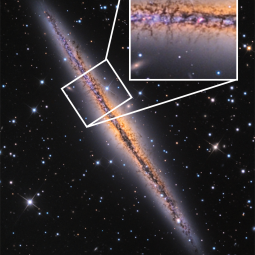By William Reach and Joan Schmelz
Paper:
Extraplanar Gas in Edge-on Galaxies Traced by SOFIA Observations of [C II]
Reach, William T., et al., 2020/10, ApJ, 902, 28.
Spiral galaxies are relatively thin, but when viewed edge-on, observers can discern emission extending above and below their midplanes. In general, this vertical distribution of material is determined by a balance between gravity from the stellar disk and pressure in the interstellar gas. But bursts of localized star formation can disturb this equilibrium. The largest stars in a cluster generate powerful winds and then explode as supernovae at the ends of their lives. Thus each cluster inputs vast amounts of energy into its surroundings, which can approach or even exceed the gravitational binding energy of material to the disk. This can drive material from the disk into the halo, leading to the formation of bubbles or vertical protrusions called chimneys.
A similar phenomenon occurs on a larger scale at the centers of some galaxies, where the exceptional rates of star formation or the supermassive black hole can produce superwinds like the one seen in M82 or large-scale Fermi bubbles like the one seen in our own Milky Way. All of these processes, either at the galactic center or in the outskirts, determine how galaxies evolve. Super star clusters can generate so much energy that they blow out their disks, destroying or disrupting the raw material required to form new stars. If this material escapes into the galactic halo, it may eventually return via a “galactic fountain” or seed the intergalactic medium with newly star-processed material.
Researchers used the FIFI-LS instrument on SOFIA to study the extra-planar distribution of [C II] in the two edge-on spiral galaxies, NGC 891 and NGC 5775. The [C II] line at 157.7 µm is the primary cooling line for diffuse atomic and molecular gas. It is a good tracer of the ISM, complementary to the HI 21-cm and Hα lines, which are sensitive to lower density gas. Emission was detected up to 2 kpc from the midplane with a scale height intermediate between those of HI 21-cm, which traces extended tidal interactions, and mid-infrared PAH emission, which traces the star-forming disk.
The [C II] scale height is greater for the segment of NGC 891 that has a current burst of star formation, as compared to a more quiescent portion of the galaxy. Also there is some spatial association between the Hα emission that traces ionized columns above the most-active star-forming regions: it appears [C II] traces molecular gas that has been elevated from the midplane and comprises the inner walls of chimneys that are illuminated by the remaining young stars in the cluster. The amount of material required to explain the extra-planar [C II] is much larger than required for the HI and Hα. Researchers conclude that the new observations show a formerly unseen component of the disk-halo interaction of the galaxy.
Researchers find that the spatial distribution of [C II] is best described by a two-component model. Each galaxy has a thinner disk with a scale-height of about 0.3 kpc. The central and active star-forming regions are supplemented by a thicker disk with a scale height of about 2 kpc.
The [C II] is far more extended than mid-infrared emission, which traces present-day massive star formation, but not as extended as the HI 21-cm emission, which traces low-metallicity circum/inter-galactic matter. The extra-planar [C II] may arise in walls of chimneys that connect the disk to the halo, where material is driven upward by stellar winds and supernovae. With these new observations, researchers see evidence for an unexpectedly large amount of material being involved in blowouts — that the walls of the chimney are surprisingly massive.
